I’m a big fan of dermatology and I want to teach people about skin cancer. It’s a common type of cancer that affects many people around the world. But, if we catch it early and take steps to prevent it, we can lower the risk a lot.
This guide will cover the signs of skin cancer and how to prevent it. We’ll look at the different types of skin cancer, who’s at risk, and why checking yourself and seeing a dermatologist is important. By knowing the signs and acting early, we can protect our skin and catch problems before they get worse.
Key Takeaways
- Skin cancer is a common health issue that affects many people worldwide.
- Spotting it early is key to getting the right treatment and better results.
- Regular self-checks and seeing a dermatologist are crucial steps.
- Using sunscreen and wearing protective clothes can lower your risk of skin cancer.
- Knowing the signs, like unusual moles or changes in skin, helps in early detection and treatment.
Understanding Skin Cancer
Skin cancer is a complex condition with various types, each with its own risk factors. It’s important to know the different types, what causes them, and their effects on people and society.
Types and Risk Factors
There are three main types of skin cancer: melanoma, basal cell carcinoma, and squamous cell carcinoma. Melanoma is the most serious, coming from cells that produce pigment. Basal cell carcinoma and squamous cell carcinoma are less severe but still need quick attention.
Many things can increase your risk of skin cancer, like spending too much time in the sun, having fair skin, a family history, or a weak immune system. People who often get sunburned, especially when young, are more likely to get skin cancer later. Those with fair skin, light eyes, and who easily freckle or burn are also at higher risk.
Prevalence and Impact
Skin cancer is a big health issue, with cases going up worldwide. In the US, it’s thought that one in five people will get skin cancer at some point. It not only affects health but also has emotional and financial impacts on those affected and their families.
| Skin Cancer Type | Prevalence in the US | Impact on Society |
|---|---|---|
| Melanoma | About 100,000 new cases per year | Leading cause of skin cancer-related deaths, with an estimated 7,650 deaths in 2020 |
| Basal Cell Carcinoma | Approximately 4.3 million new cases per year | Highly treatable, but can cause significant disfigurement if left untreated |
| Squamous Cell Carcinoma | Approximately 1 million new cases per year | Can be aggressive and metastasize if not detected and treated early |
Knowing about skin cancer types, risk factors, and its effects helps people prevent and manage it better.
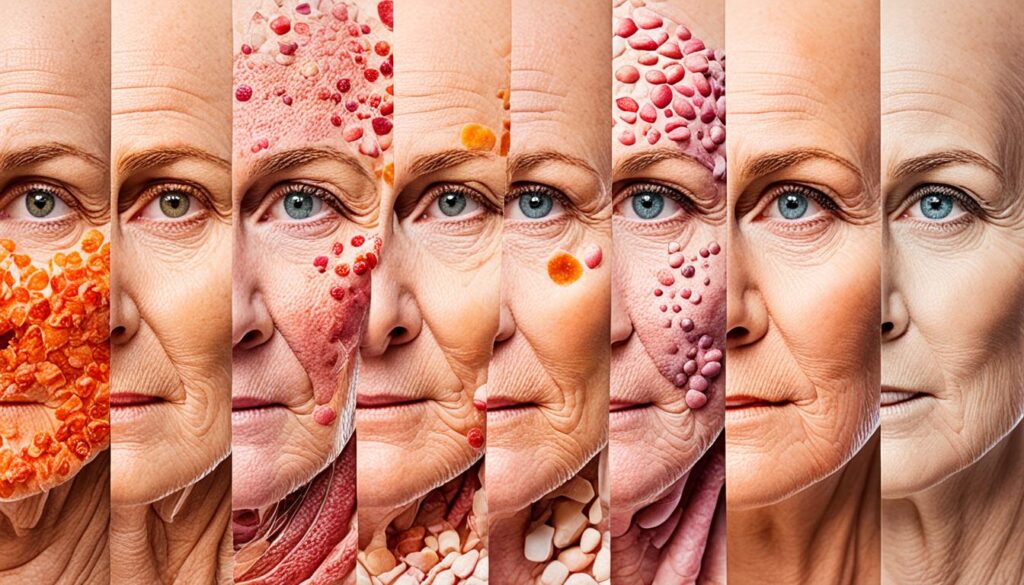
Recognizing the Warning Signs
It’s key to spot early signs of skin cancer for quick treatment. The ABCDE rule is a great way to notice changes in your skin.
Abnormal Mole Characteristics
The ABCDE rule helps you see what to look for in moles and spots:
- Asymmetry: The mole’s halves don’t match in size or shape.
- Border: The mole’s edges are odd, rough, or unclear.
- Color: The mole has mixed colors, like brown, black, red, white, or blue.
- Diameter: The mole is bigger than 6 millimeters, as big as a pencil eraser.
- Evolving: The mole changes in size, shape, color, or height over time.
If you see these signs in your skin, see a dermatologist right away. Early catching is key for skin cancer signs, abnormal moles, and melanoma symptoms.

Not all moles with these signs are cancer, but it’s wise to check them with a doctor. Being alert and knowing the signs helps you protect your skin health.
Skin Cancer Signs, Skin Cancer Prevention, Sun Protection, Dermatology, Melanoma
Understanding skin health is key to spotting skin cancer signs early. We’ll cover how to prevent it and what to look for in moles. This will help you catch skin cancer early.
Skin cancer comes in different types, like basal cell carcinoma and melanoma. It’s getting more common, but we can lower our risk. Using sunscreen and wearing protective clothes is crucial for prevention.
Dermatologists are experts in skin health. They can spot and treat skin issues, including cancer. Seeing a dermatologist often can help find skin cancer early, which is key to beating it.
Knowing the signs of skin cancer is the first step in prevention. Look for moles that change size, shape, or color. Regular self-checks help spot problems early.
“Early detection is the key to successful skin cancer treatment, and regular skin self-exams can be a lifesaving practice.” – Dr. Sarah Menton, board-certified dermatologist
Preventing skin cancer means using sunscreen, checking your skin often, and getting medical help fast. Taking care of your skin can reduce the risk of skin cancer. This way, you can keep your skin healthy and glowing.
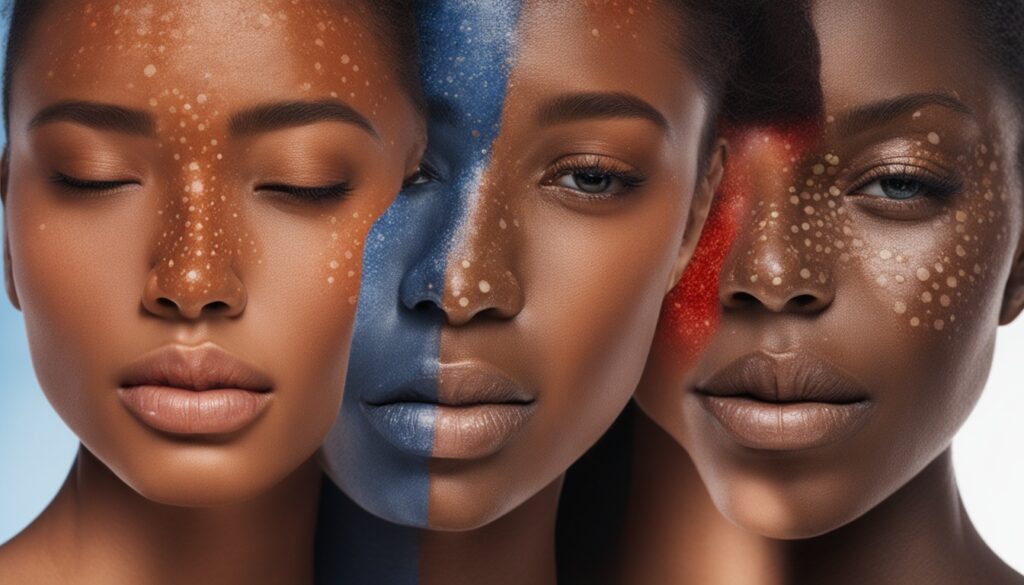
- Skin cancer signs: Irregular moles, changes in skin texture, new growths
- Skin cancer prevention: Sunscreen, protective clothing, regular skin self-exams
- The role of dermatology: Early detection, diagnosis, and treatment of skin cancer
- Melanoma: The most serious form of skin cancer, requiring prompt attention
| Skin Cancer Type | Characteristics | Risk Factors |
|---|---|---|
| Basal Cell Carcinoma | Slow-growing, waxy, and pearly in appearance | Excessive UV exposure, fair skin, personal or family history |
| Squamous Cell Carcinoma | Scaly, rough, and red in color | Chronic sun exposure, weakened immune system, previous skin cancer |
| Melanoma | Asymmetrical, irregular borders, varying colors | Genetic predisposition, UV exposure, multiple or atypical moles |
The Importance of Early Detection
Early detection is key in fighting skin cancer. By checking our skin often and watching for changes, we can spot skin cancer, like melanoma, early. This helps us treat it better and increases our chances of getting better.
When we find skin cancer early, treatments are simpler and work better. In the early stages, it can often be treated with simple surgery or other targeted treatments. This leads to a better chance of fully recovering.
Waiting to find skin cancer can make it harder to treat. It might need more surgery, radiation, or chemotherapy. This shows why finding it early is so important.
Checking ourselves and seeing a dermatologist regularly helps catch skin problems early. Being proactive with our skin health helps us take control of our health. It also boosts our chances of a good outcome if we do get skin cancer.
“Early detection is the best protection when it comes to skin cancer. Regularly checking your skin and seeking medical attention for any suspicious changes can make all the difference.”
Using early detection is a key step in fighting skin cancer and melanoma. Making skin checks a regular part of our health routine helps us catch the disease early. This makes it easier to treat.
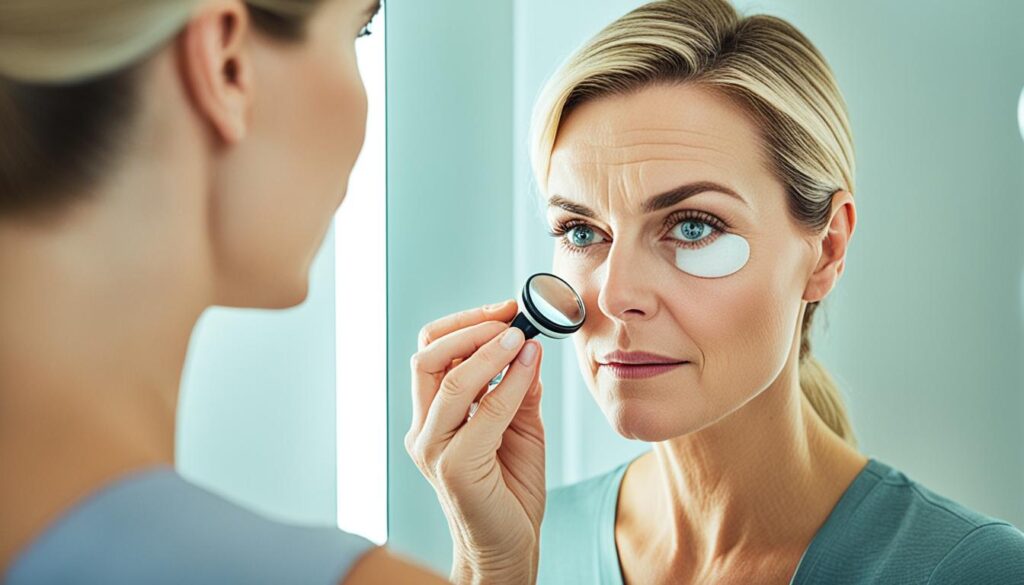
Performing Skin Self-Exams
Regular skin self-exams are key to finding skin cancer early, like melanoma. By knowing how to do it and paying attention to your skin, you can spot warning signs. This guide will help you do a skin self-exam right.
A Comprehensive Skin Self-Examination
To do a thorough skin self-exam, check your whole body from head to toe. Here’s how to make sure you cover all areas:
- Start in a well-lit room and use a full-length mirror to see your whole body, including your back, scalp, and hard-to-see spots like between your toes and behind your ears.
- Use a hand-held mirror to look at your face, neck, ears, and scalp closely. Watch for any changes or oddities.
- Look at your arms, including your hands’ palms and the underside of your arms.
- Check your legs, including the tops of your feet, the soles, and the spaces between your toes.
- Don’t skip your back. Use a hand-held mirror or ask someone to help you see it.
Look for any changes in your skin’s size, shape, color, or texture. Also, watch for new moles or growths.

| Characteristic | Description |
|---|---|
| Asymmetry | One half of the mole or growth does not match the other half. |
| Border | The edges are irregular, ragged, notched, or blurred. |
| Color | The color is uneven, with shades of tan, brown, black, red, white, or blue. |
| Diameter | The diameter is larger than 6 millimeters (about the size of a pencil eraser). |
| Evolving | The mole or growth is changing in size, shape, or color. |
Being thorough and consistent is key to good skin self-exams. Make it a habit to increase your chances of finding skin cancer early. Early detection means better treatment outcomes.
The Role of Dermatologists
Dermatologists are key in finding and treating skin cancer early. They know how to spot and handle different skin cancers, including the dangerous kind, melanoma.
It’s very important to see a dermatologist often if you’re at risk. This includes people with a family history, light skin, or who spend a lot of time in the sun. During these visits, they check your skin for any odd spots or changes that could mean skin cancer.
Dermatologists use special tools like dermoscopy and biopsies to find and diagnose skin cancer. Then, they decide on the best treatment. This could be surgery, creams, or other treatments, based on the cancer type and stage.
Dermatologists work closely with their patients to catch skin cancer early and treat it fast. This can greatly improve how well a patient does and lower the chance of serious problems.
“Early detection and prompt treatment are key to successfully managing skin cancer. Regular visits to a dermatologist can make all the difference.”
Dermatologists also teach people about preventing and recognizing skin cancer. They share their knowledge to help others protect their skin and spot problems early.
The work of dermatologists is very important in fighting skin cancer. They use their skills, new methods, and teach patients to improve skin health and save lives.
Sun Protection Strategies
Protecting your skin from the sun’s harmful UV rays is key to preventing skin cancer. Using a mix of methods is important for sun protection. This includes picking the right sunscreen and wearing sun-protective clothing.
Sunscreen and Protective Clothing
Sunscreen is your first defense against the sun’s harmful rays. Choose broad-spectrum sunscreens with an SPF of 30 or higher. Apply it to all skin 15 minutes before going outside. Reapply every two hours, or more if you’re swimming or sweating.
- Choose a sunscreen that protects against both UVA and UVB radiation.
- Apply a sufficient amount of sunscreen – about one ounce per application for an average-sized adult.
- Seek shade whenever possible, especially during the peak UV hours of 10 a.m. to 4 p.m.
Protective clothing also helps shield your skin from the sun. Wear lightweight, long-sleeved shirts, pants, and broad-brimmed hats. Choose fabrics with a tight weave or a UPF (ultraviolet protection factor) rating for better protection.

“The key to effective sun protection is to use a combination of strategies, including sunscreen, protective clothing, and seeking shade.”
By using these sun protection tips every day, you can lower your risk of skin cancer. This lets you enjoy the outdoors with confidence.
Lifestyle Factors and Risk Reduction
Skin cancer is a big health worry, but we can control many risk factors. By choosing wisely in our daily lives, we can lower our risk of getting this disease. Let’s look at how our daily habits affect skin cancer prevention.
UV exposure is a top risk factor for skin cancer, from the sun or tanning beds. Spending less time in the sun, especially during the hottest parts of the day, helps. Using sunscreen and wearing protective clothes like hats and long sleeves also protects you from UV rays.
| Lifestyle Factor | Impact on Skin Cancer Risk |
|---|---|
| Excessive UV Exposure | Significantly Increases Risk |
| Tanning Bed Use | Dramatically Raises Risk |
| Healthy Diet and Exercise | May Reduce Risk |
| Smoking | Linked to Higher Risk |
Other lifestyle choices also affect your skin cancer risk. Eating well and staying active can boost your body’s fight against cancer cells. But, smoking is linked to a higher risk of some skin cancers.
By choosing to limit UV exposure, skip tanning beds, and live healthily, you can lower your skin cancer risk. Prevention is crucial, and small daily changes can greatly improve your skin health over time.

“The best defense against skin cancer is prevention, and that starts with understanding the risk factors and taking proactive steps to protect your skin.”
Skin Cancer and Melanoma: Myths and Facts
There are many myths about skin cancer and melanoma that can confuse people. We will clear up these myths and share the facts. This will help readers understand skin cancer and melanoma better, so they can take good care of their skin.
Myth: Skin Cancer Only Affects Older Adults
Skin cancer is not just for older people. It can happen to anyone, at any age. It’s true that older people are more likely to get it, but everyone should watch their skin health.
Fact: Skin Cancer Can Develop in Anyone
Anyone can get skin cancer, no matter their age, skin type, or background. It’s important for everyone to check their skin regularly and protect it from the sun.
Myth: Dark-Skinned Individuals Don’t Need Sun Protection
Even people with darker skin can get skin cancer, including melanoma. Everyone needs to protect their skin from the sun, no matter their skin color.
Fact: Skin Cancer Can Affect All Skin Types
- Dark-skinned people are less likely to get skin cancer, but they’re not safe from it.
- Checking your skin regularly and staying sun-safe is important for everyone, no matter their skin color.
| Skin Cancer Myths | Skin Cancer Facts |
|---|---|
| Skin cancer only affects older adults | Skin cancer can happen to people of all ages |
| Dark-skinned individuals don’t need sun protection | All skin types can get skin cancer |
We need to fight these myths with facts to help people prevent and catch skin cancer and melanoma early. Regular skin checks, protecting your skin from the sun, and acting early are key to keeping your skin healthy and lowering your risk.

“Skin cancer is the most common type of cancer, but it is also one of the most preventable. By understanding the facts and taking proactive measures, we can significantly reduce the burden of this disease.”
Identifying High-Risk Individuals
Some people face a higher risk of getting skin cancer because of their family history and genetic predisposition. Knowing about these skin cancer risk factors helps find those who need extra care in checking for skin cancer and preventing it.
Family History and Genetic Predisposition
If a family member, like a parent or sibling, has had skin cancer, your risk goes up. This is because some genes that lead to skin cancer can be passed down. Some people might also be more likely to get skin cancer, even if no one in their family has had it.
- Having a first-degree relative with skin cancer makes your risk higher.
- Certain genetic syndromes, like xeroderma pigmentosum and FAMMM syndrome, also raise your risk.
- Regular skin checks and catching skin cancer early are key for those with a family history or genetic risk.
Identifying those at high risk lets doctors work with them to create plans for preventing skin cancer. This can lead to better health outcomes and less cases of this preventable disease.
| Risk Factor | Increased Skin Cancer Risk |
|---|---|
| Family History | 2-3 times higher |
| Genetic Predisposition | Up to 10 times higher |
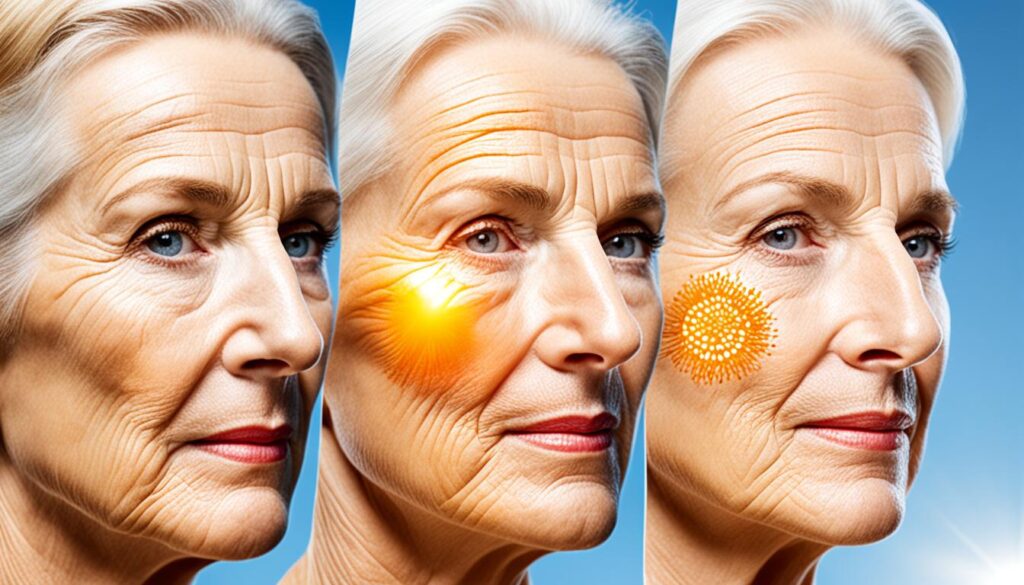
“Early detection and prevention are key when it comes to managing skin cancer risk, especially for those with a family history or genetic predisposition.”
Treatment Options for Skin Cancer
Early detection is key when it comes to skin cancer. But, treatment options are just as important. The type and stage of the cancer determine the best way to treat it.
Surgical procedures are a main way to treat skin cancer. This can mean excision, Mohs surgery, or cryosurgery. The cancerous area is removed or frozen to get rid of the bad cells. These methods work well for early and localized skin cancers.
For more serious skin cancers like melanoma, radiation therapy might be an option. It uses high-energy particles or waves to kill cancer cells without hurting healthy ones nearby.
Chemotherapy and targeted therapies are also used to fight skin cancer. Chemotherapy uses drugs to stop cancer cells from growing. Targeted therapies find and destroy cancer cells by targeting specific molecular mechanisms.
Choosing the right treatment depends on many factors. These include the cancer type, stage, the patient’s health, and what they prefer. Working closely with a dermatologist or oncologist is key to finding the best treatment plan.
The main goal is to get rid of the skin cancer while keeping side effects low and quality of life high. Thanks to medical research and many treatment choices, skin cancer treatment is getting better.
“Early detection and proper treatment are the keys to successful management of skin cancer. By working closely with a healthcare provider, patients can explore the most suitable options and achieve the best possible outcomes.”
Emotional and Psychological Support
Getting a skin cancer diagnosis is tough and can feel overwhelming. The emotional and psychological effects of skin cancer, including melanoma, are often overlooked. People may feel scared, anxious, depressed, and isolated.
It’s key to understand the mental health side of skin cancer. We need to support those affected well. This journey needs resilience, kindness, and access to good resources. We’ll look at why emotional and psychological support is important for skin cancer patients and their families. We’ll also talk about resources to help them cope with their challenges.
Addressing the Emotional Toll
A skin cancer diagnosis brings many feelings, including:
- Fear and uncertainty about the prognosis and treatment
- Anxiety about how it will change one’s appearance and self-image
- Feelings of isolation and not being understood by friends and family
- Depression and grief over the big changes in life
These feelings can really affect someone’s mental health and life quality. It’s important to deal with these emotions to stay strong and healthy during treatment and recovery.
Coping Strategies and Support Services
There are many resources and support services for those with skin cancer and their families. These include:
- Counseling and therapy: Talking to a mental health expert can help you deal with feelings and find ways to cope.
- Support groups: Being part of a support group can make you feel connected and let you share and learn from others.
- Educational resources: Getting reliable info on skin cancer, its treatment, and how it affects you can make you feel more in control.
- Self-care practices: Doing things that are good for your mind and body, like meditation, exercise, or making art, can help with stress and staying positive.
Using these resources and services can help you stay strong and emotionally well. This way, you can face the challenges of skin cancer with more confidence and hope.
Remember, asking for emotional and psychological support is brave. It shows you’re putting your health and well-being first during a tough time.
Raising Awareness and Advocacy
Promoting skin cancer awareness is key in fighting this disease. Many campaigns aim to teach the public, push for early detection, and help those with skin cancer. Groups, health experts, and leaders lead these efforts, making a big difference and spreading the word on preventing skin cancer.
Campaigns and Initiatives
The annual Skin Cancer Awareness Month in May is a big push. It helps people understand skin cancer, its risks, and the need for regular skin checks. During this month, health groups, charities, and local areas host events, screenings, and programs to educate and help people.
The American Academy of Dermatology’s (AAD) SPOT Skin Cancer™ program is another big push. It gives people tools to learn about skin cancer, check themselves, and find free screenings near them.
- The AAD’s “SPOTme®” campaign teaches people to “SPOT skin cancer, SCREEN yourself, and PROTECT your skin” with educational stuff and events.
- “Melanoma Monday” on the first Monday of May focuses on the most deadly skin cancer and why catching it early is key.
Local groups also run skin cancer campaigns. They offer free screenings, teach about sun safety, and give out sunscreen and protective gear to those who need it most.
Working with these groups and supporting their work helps us all fight skin cancer awareness. By doing this, we can make a big difference in stopping this preventable disease.
Emerging Trends and Research
The field of skin cancer research is changing fast, with new discoveries and advancements. These changes are shaping how we diagnose, treat, and prevent skin cancer. We will look at the latest trends and research that could change how we handle skin cancer.
Advanced imaging technologies are now a big deal in skin cancer research. Researchers are looking into high-resolution imaging like reflectance confocal microscopy and optical coherence tomography. These tools help spot skin cancer early and make diagnoses more accurate. They give doctors a clear view of skin lesions without needing surgery.
There are also big steps forward in targeted therapies for skin cancer. Scientists are working on new treatments like checkpoint inhibitors and personalized vaccines. These treatments aim to boost the immune system to fight skin cancer better. This could lead to better patient results and fewer side effects from treatments.
Researchers are also looking into ways to prevent skin cancer. They’re studying how things like diet, exercise, and sun protection can lower skin cancer risk. By understanding these factors, they hope to find ways to prevent skin cancer before it starts.
The future of skin cancer research is full of hope and new ideas. With advanced imaging and personalized treatments, we could change how we fight skin cancer. Keeping up with research helps doctors and the public work towards a future where skin cancer is easier to detect, treat, and prevent.
| Research Area | Key Innovations | Potential Impact |
|---|---|---|
| Imaging Technologies | Reflectance confocal microscopy, optical coherence tomography | Improved early detection and diagnostic accuracy |
| Targeted Therapies | Immunotherapies, personalized vaccines | Enhanced treatment options and patient outcomes |
| Preventive Interventions | Lifestyle factors, sun exposure, dietary modifications | Reduced skin cancer risk and incidence |
“The future of skin cancer research holds immense promise, with groundbreaking advancements that will transform the way we approach this disease. By harnessing the power of innovation and collaboration, we can pave the way for a future where skin cancer is more effectively detected, treated, and ultimately, prevented.”
Conclusion
In this guide, we’ve looked at skin cancer from many angles. We’ve covered its types, risk factors, warning signs, and how to prevent it. By keeping up with information and checking our skin often, we can help protect our health.
It’s clear what we need to do: check ourselves regularly, work with skin doctors, and use strong sun protection. By staying alert and learning about new research and treatments, we can catch skin cancer early. This leads to better health and a better life.
Preventing skin cancer is a team effort. By spreading the word and supporting skin cancer programs, we help our communities focus on skin health. Together, we can make a difference and ensure a healthier future for everyone.

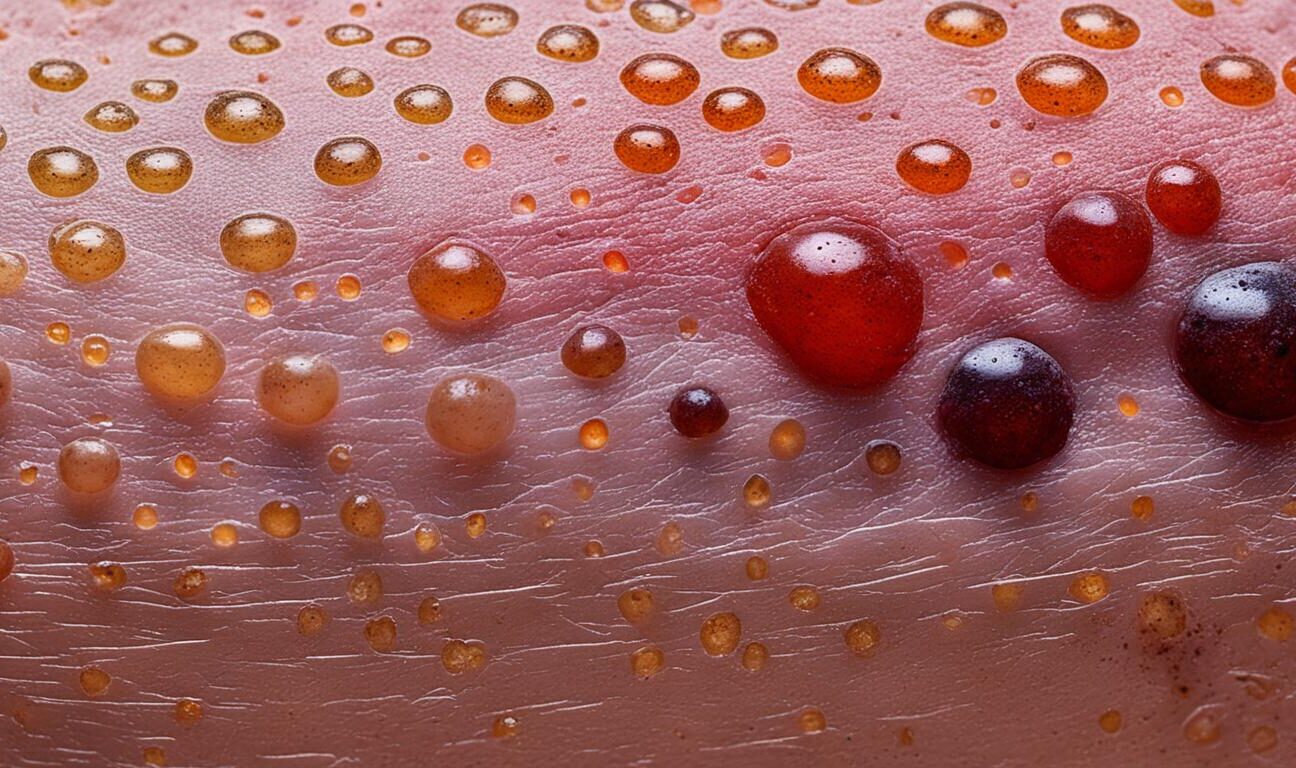

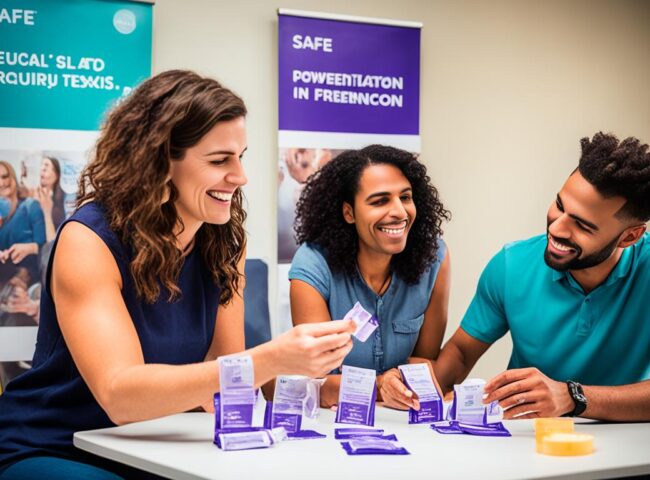



Leave feedback about this